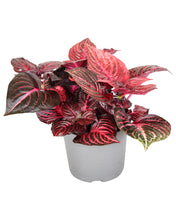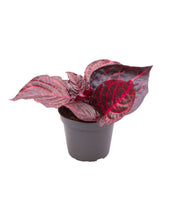Iresine herbstii is now known as Iresine diffusa f. Herbstii.
Iresine diffusa f. Herbstii is part of the Amaranthaceae family and its native range is N. Peru where it grows as a subshrub and grows primarily in the wet tropical biome.
It’s commonly known as bloodleaf and is sought after for its intensely coloured foliage. This Iresine species features oval-shaped leaves that display striking shades of deep red, purple, or green, often with prominent veins in contrasting colours like bright red or pink.
Genus name is derived from the Greek word "eiresione," referring to a wreath or staff traditionally adorned with woolly strips, which alludes to the woolly hairs often found around the calyx of the species within the Iresine genus. Specific epithet (diffusa) means diffused or spreading, this is in reference to the growth habit.
Light: Iresine herbstii thrives in bright, indirect light. Strong, direct sunlight can harm its leaves, potentially causing scorching or dulling the vibrant colours. Insufficient light may result in stretched stems and less intense foliage coloration. A position near a window with filtered light in a typical UK home is ideal. Brighter light is often necessary to maintain the deepest reds and purples.
Water: The potting mix should be kept consistently damp but not saturated. Allow the upper inch of the soil to dry between waterings. This plant dislikes drying out completely. Ensure the pot drains exceptionally well to prevent root problems. Reduce watering in autumn and winter when the plant's growth naturally slows.
Soil: A well-draining potting mix is essential. A standard houseplant compost, possibly mixed with perlite to improve aeration, is often recommended.
Fertilising: Use a diluted liquid fertiliser every two to four weeks during the active growing period in spring and summer. Reduce or stop fertilising during the autumn and winter months.
Temperature: This plant prefers warm temperatures, ideally between 18°C and 27°C. It is not tolerant of frost and should be shielded from cold draughts and temperatures below 10°C, which can occur indoors, particularly during colder UK months. If used as bedding, it must be planted out after the last risk of frost.
Humidity: Iresine herbstii appreciates moderate to higher humidity levels. Consider placing the plant on a pebble tray with water or grouping it with other plants to maintain optimal conditions, especially during drier indoor periods in the UK.
Growth Habit: It typically grows as a bushy, upright perennial, though its stems can become somewhat sprawling if not regularly pinched back. Regular pruning encourages a more compact and fuller shape.
Toxicity: Iresine herbstii is generally considered non-toxic to humans and pets.



